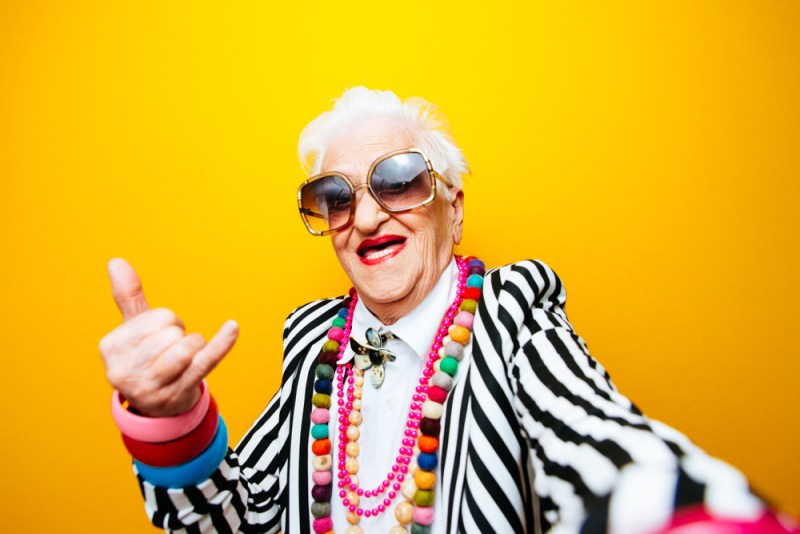As a part of our ongoing coverage of Women’s History Month and International Women’s Day, Oola is highlighting inspiring women across a variety of sectors. To tell this story about ageism, we partnered with Attn:Grace, whose mission is to destigmatize aging for women.
When you’re browsing the internet, watching TV, or scrolling through social media, you’re bound to come across some sort of message about aging. Whether you come across an ad for the latest beauty product promising a youthful glow or a post sharing the resistance to turning another year older, the underlying message we’re constantly faced with is the same: aging is seen in a negative light, but it doesn’t have to be.
The Stigma of Aging

How many times have you seen turning 30 depicted as a life-altering moment in media? There’s a glorification of your 20s being your golden years and the idea that any age beyond that is something to dread. There’s societal pressure to “have it all” or have everything figured out by the time you turn 30, however, this doesn’t take into account the many paths, definitions of success, and life goals that women have.
One area where the aging stigma is prevalent is in romantic relationships. One study by the University of Missouri-Columbia explored the stigma of women who aren’t married by their mid-30s. According to the study, participants reported societal pressures arose from feeling both “visible and invisible” because of their age and relationship status. According to participants, social situations like the bouquet toss at a wedding made them feel more visible as a single woman in their mid-30s whereas not feeling seen when others make assumptions that they are married with children and may feel pressure to explain why they are single.
Ageism in the Workplace

Romance isn’t the only area where there’s an aging stigma—ageism also happens in the workplace. While age discrimination is illegal, it’s not uncommon, as employers may wrongfully assume that older workers aren’t as tech-savvy, skillful, or productive as younger candidates, the World Health Organization says. According to a survey by the AARP, nearly three out of five employees ages 45 and older have seen or experienced age discrimination at work. The survey also found that about one in four older workers have received negative comments about their age from their bosses or coworkers.
Unfortunately, workplace ageism tends to occur earlier for women than it does for men, with women being affected by age 40 and men by age 45. The chance for age discrimination in the workplace earlier on may lead to women being more susceptible to being laid off, passed over for a promotion, or not being hired at all because of their age. However, a survey by Fairygodboss found that in order to avoid ageism at work, 22% of women were more likely to color their hair to appear younger, which leads to an even larger industry where there’s a major aging stigma: beauty.
Aging and the Beauty Industry

According to a survey by AARP on beauty, age, and media, 89% of women ages 18 and over said that beauty and personal grooming are at least somewhat important to them. Although a majority of women reported consuming beauty or personal grooming products, older women said they felt ignored by the industry and under-represented in advertising. Specifically, Boomers (individuals born between 1946 and 1964) reported feeling like an afterthought and wished ads had more realistic images of people. But overall, 69% of women across all age groups 18 and older felt that media images are ageist.
While society’s beauty standards have shifted to be more age diverse and inclusive over time, beauty is a profitable industry, with a global market estimated at $58.5 billion in 2020 for anti-aging alone. There are societal pressures to “age gracefully” and “look great for your age,” phrases typically meant to be compliments but only reinforce the idea that looking younger is something to be celebrated or congratulated rather than embracing the natural process of aging. Effects of aging, such as fine lines and gray hair, are seen as “problems” that need to be fixed, adding to the stigma of aging.
Changing the Conversation About Aging

Overall, there’s an increased awareness of the ageism older people face in all aspects of living. In the workplace, for example, employers and employees can reframe the unnecessary age bias of older workers. “Employers are looking for people with soft skills, like being good with teamwork or collaboration or being able to write well,” Susan Weinstock, vice president of financial resilience programming for AARP, says. “These are skills older workers have developed through their years of experience.”
There’s also a shift in the conversation of aging and appearance. A 2014 poll found that two-thirds of Americans ages 65 and older reported that they “agreed” or “strongly agreed” that they always felt good about their physical appearance suggesting some older Americans are less concerned with the pressure to look younger. In comparison, 61% of Americans ages 18 to 34 and 54% of middle-aged Americans reported feeling confident in their bodies.
Despite the stigma of aging, growing older is inevitable and a privilege that not everyone has. And regardless of the pressure to look younger, we’re collectively shedding the negative stereotypes and perceptions of aging.

